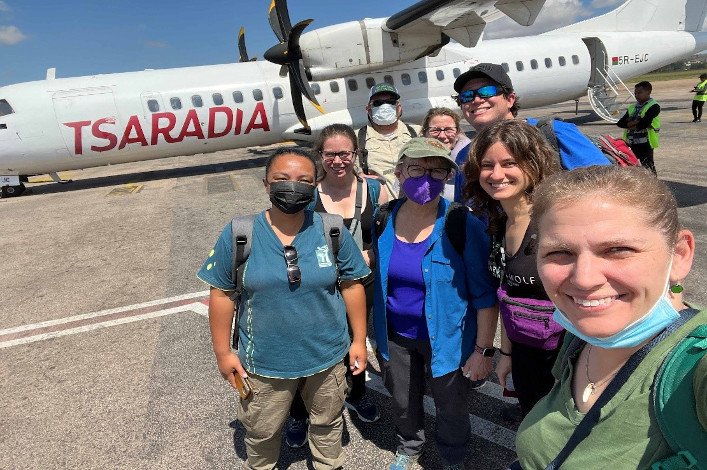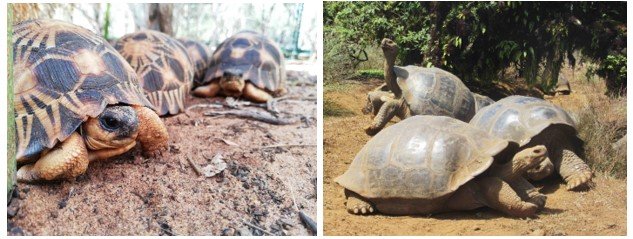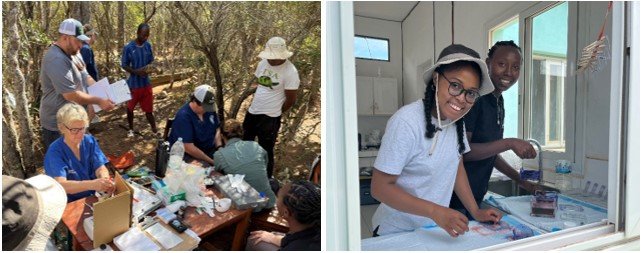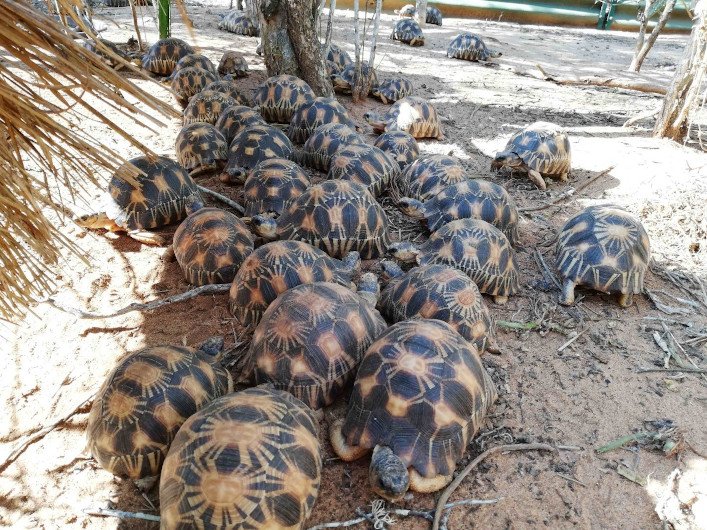Author: Ainoa Neito, Associate Researcher of the Saint Louis Zoo Institute for Conservation Medicine and former CDF staff member
Over the last decade, tens of thousands of radiated tortoises have been confiscated from poachers. The Turtle Survival Alliance (TSA) has been charged with the care and management of these animals since their confiscation. In November 2022, staff from different conservation institutions traveled to southern Madagascar to perform health evaluations of critically endangered radiated tortoises slated to be released back into the wild. Dr. Ainoa Nieto Claudin, field veterinarian and CDF associated researcher participated on this expedition as part of the Saint Louis Zoo Institute for Conservation Medicine team Dr. Nieto Claudin has spent the last decade studying giant tortoise health on the Galapagos Islands. This was her first trip to Madagascar to work with radiated tortoises.
It is pitch black when we finally reach our destination. A high wall surrounds the entire perimeter, and two armed guards receive us with a grim look. We are tired, hungry, and dusty after the long journey, and everything takes on a certain tinge of unreality. After verifying who we are and why we are here, the guards let us in. We park the trucks and walk the few meters that separate us from what will be our home for the next two weeks. A single bulb illuminates a small building, and the dimensions of the place are not clearly distinguished. Darkness reigns, and the sky is starrier than ever. The night sky of the southern hemisphere again!
Our local partners help us settle into two small rooms. There are several mattresses strategically placed on the floor; it is hot and I am surprised that there are not many mosquitoes. The five women on the team huddle together in one room, while two men share the other. Curiously, we are a team made up mainly of women, which is still an exception in the scientific world. Dinner is waiting, and the food wakes us up from the travel drowsiness. I try to remember how many days we've been traveling, but I've lost count. I remember the flight that took me from Madrid to Paris and then boarding the Boeing 777 that would take me to Antananarivo, the capital of Madagascar. From there, another small plane carried us to the south of this huge island, where the 4x4 trucks were waiting to drive the last 8 hours of our journey. Microscopes, centrifuges, medical, and laboratory supplies, two large portable freezers, and several kilos of reagents and materials made the trip with us. But we're here, we made it!

We are at the Tortoise Conservation Center (TCC), run by the Turtle Survival Alliance, in southern Madagascar. The actual location of the TCC is kept secret, and the security measures are tight. If I didn’t know any better, I would think this place holds more than just tortoises... But at the TCC, tortoises are the hot commodity needing protection. Illegal species trafficking networks are so powerful that all of these security measures are necessary to preserve a few thousand animals. It may be surprising that Madagascar tortoises are some of the most trafficked species in the world. The reason is very simple: they are beautiful. I think of the Galapagos tortoises, with whom I have worked for so many years, and I can't help but compare them: the radiated tortoises of Madagascar win in beauty by a landslide, but they’re no match in size with the giants of Galapagos...

Our team is made up of five veterinarians, two technicians, and a keeper. We have a mission to accomplish: to determine the health status of the two thousand radiated tortoises (Astrochelys radiata) that are waiting to be released back into the wild. There is so much work to be done.
Workdays are long. We start early each morning to avoid the intense heat of midday (for us and the tortoises), then we start again in the late afternoon as some samples need to be analyzed immediately. We collected blood samples and oral and cloacal swabs from a subset of the tortoises to assess their health and diseases. More daunting a task, we need to conduct health checks on all 2,000 tortoises and place microchips under the skin, which will allow for individual identification later. There isn't much time to rest, but the ring-tailed lemurs visit us every afternoon to cheer us up and remind us of where we are: Madagascar!

I remember again that just a couple of months ago I was on another island, in another ocean, working with other tortoises. It is all so different, but at the same time so similar… The threats that the Galapagos tortoises face are the same faced by Madagascar tortoises, albeit in Madagascar on a much larger scale. Deforestation and habitat destruction, pollution, climate change, introduced species, disease, and illegal trafficking, to name just a few... And so the work is repeated. Carry out health assessments to find out the diseases that are present in these species, recover those animals that have been victims of illegal trafficking and ensure that they do not carry any disease that could affect wild tortoises, raise awareness among the authorities and institutions so that they can take action... there is so much to do.
Every year, thousands of Madagascar tortoises are seized in international illegal species trafficking networks. To this end, we must also consider all those that make it past the security filters to be sent all around the world. The numbers are heartbreaking. In Galapagos, things are not so different, but the numbers are smaller. In recent years, several events of illegal trafficking in Galapagos giant tortoises have been documented and have been covered by international media.

Sitting in the restaurant in one of the most emblematic national parks of Madagascar, where numerous endemic species can still be seen (unfortunately not tortoises), I reflect on the future of Galapagos and Madagascar. Two places so distant and at the same time so close in terms of the challenges they face to preserve their endemic species. Fortunately, in both places I have met many determined people committed to the conservation, education, and protection of unique and fascinating creatures: tortoises, marine iguanas, lemurs, and chameleons. All emblematic and charismatic species that play a fundamental role in preserving the health and well-being of their ecosystems. It is our responsibility to ensure that these species have a future. We owe it to them. We owe it to ourselves.





